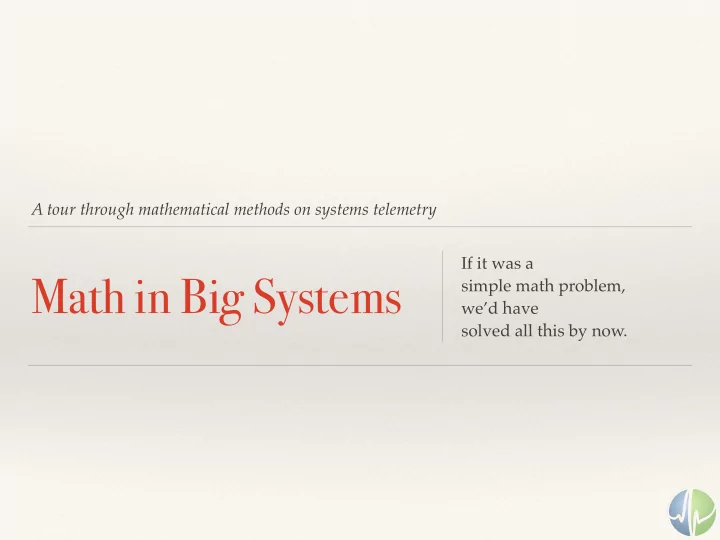

A tour through mathematical methods on systems telemetry If it was a Math in Big Systems simple math problem, we’d have solved all this by now.
The many faces of Theo @postwait Schlossnagle CEO Circonus
Picking an Approach Statistical? Machine learning? Supervised? Ad-hoc? ontological? (why it is what it is)
tl;dr Apply PhDs Apply PhDs Rinse Wash Repeat
Garbage in, category out. Understanding a signal Classification We found to be quite ad-hoc At least the feature extraction
A year of service… I should be able to learn something. API requests/second 1 year
A year of service… I should be able to learn something. API requests 1 year
A year of service… I should be able to learn something. API requests ∆ v 1 year ∆ t, ∀ ∆ v ≥ 0
Some data goes both ways… Complicating Things Imagine disk space used… it makes sense as a gauge (how full) it makes sense as rate (fill rate)
Error + error + guessing = success How we categorize Human identify a variety of categories. Devise a set of ad-hoc features. Bayesian model of features to categories. Human tests. https://www.flickr.com/photos/chrisyarzab/5827332576
Many signals have significant noise around their averages A single “obviously wrong” Signal Noise measurement… is often a reasonable outlier.
A year of service… I should be able to learn something. API requests/second 1 year
At a resolution where we witness: “uh oh” API requests/second 4 weeks
Is that super interesting? But, are there two? three? API requests/second 4 weeks
Bring the noise! API requests/second 2 days
Think about what this means… statistically API requests/second 1 year envelope of ±1 std dev
Lies, damned lies, and statistics Simple Truths Statistics are only really useful with p-values are low. p ≤ 0.01 very strong presumption against null hyp. 0.01 < p ≤ 0.05 strong presumption against null hyp. 0.05 < p ≤ 0.1 low presumption against null hyp. p > 0.1 no presumption against the null hyp. from xkcd #882 by Randall Munroe
60% of the time… it works every time. What does a p-value have to do with applying stats? It turns out a lot of The p-value problem measurement data (passive) is very infrequent.
Our low frequencies lead us to questions of doubt… Given a certain statistical model: How many few points need to be seen before we are sufficiently confident that it does not fit the model (presumption against the null hypothesis)? With few, we simply have outliers or insignificant aberrations. http://www.flickr.com/photos/rooreynolds/
Solving the Frequency Problem More data, more often… (obviously) OR 1. sample faster (faster from the source) 2. analyze wider (more sources)
Increasing frequency is the only option at times. Without large-scale systems Signals of Importance We must increase frequency
Most algorithms require measuring residuals from a mean Calculating means is “easy” Mean means There are some pitfalls
Newer data should influence our model. Signals change The model needs to adapt. Exponentially decaying averages are quite common in online control systems and used as a basis for creating control charts. Sliding windows are a bit more expensive.
Repeatable outcomes are needed In our system… We need our online algorithms to match our offline algorithms. This is because human beings get pissed off when they can’t repeat outcomes that woke them up in the middle of the night. EWM: not repeatable SWM: expensive in online application
Repeatable, low-cost sliding windows Our solution: fixed rolling windows of lurching windows fixed windows
actual math Putting it all together How to test if we don’t match our model?
Hypothesis Testing
The CUSUM Method
Applying CUSUM API requests/second 4 weeks CUSUM Control Chart
Can we do better? Investigations The CUSUM method has some issues. It’s challenging when signals are noise or of variable rate. We’re looking into the Tukey test: • compares all possible pairs of means • test is conservative in light of uneven sample sizes https://www.flickr.com/photos/st3f4n/4272645780
High volume data requires a different strategy What happens when we 10k measurements/second? more? on each stream… get what we asked for? with millions of streams.
Let’s understand the scope of the problem. First some realities This is 10 billion to 1 trillion measurements per second. At least a million independent models. We need to cheat. https://www.flickr.com/photos/thost/319978448
https://www.flickr.com/photos/meddygarnet/3085238543 When we have to much, simplify… Information We need to look at a transformation of the data. compression Add error in the value space. Add error in the time space.
Summarization & Extraction ❖ Take our high-velocity stream ❖ Summarize as a histogram over 1 minute (error) ❖ Extract useful less-dimensional characteristics ❖ Apply CUSUM and Tukey tests on characteristics
Modes & moments. Strong indicators of shifts in workload
Useful if you understand the Quantiles… problem domain and the expected distribution.
Q: “What quantile is 5ms of latency?” Useful if you understand the Inverse Quantiles… problem domain and the expected distribution.
Recommend
More recommend